Union Infantry Guide: Part 3
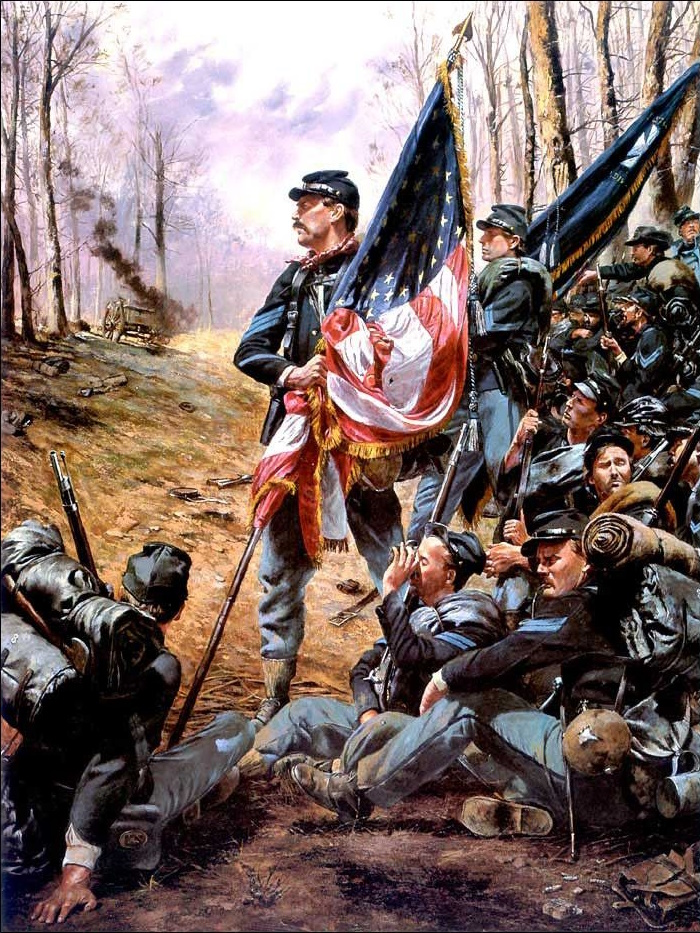
The following is a comprehensive list of all infantry units in the mod that are currently available to the Union. This guide is intended to not only show what units are available, but to also give players a quick reference to where those units can be recruited from in the mod, the weapons they are equipped with, as well as which faction and generals they are assigned to.
This guide is organized according to the type of unit, their home state (in alphabetical order), and their designated number (if applicable).
Infantry
Pennsylvania
76th Pennsylvania Infantry "Keystone Zouaves"
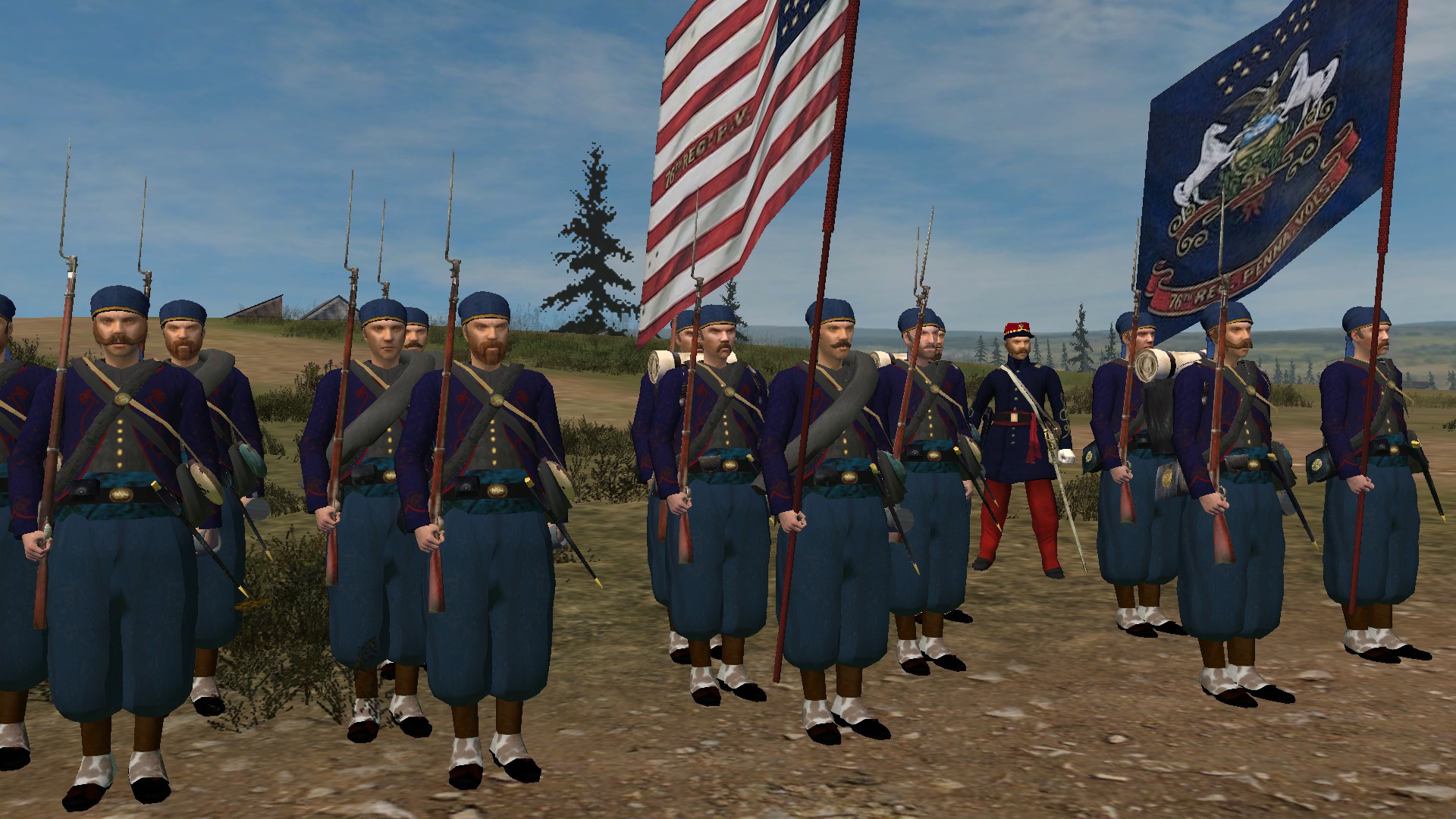
Weapons: Springfield Model 1861 Rifle Musket, Springfield Model 1863 Rifle Musket
Faction: Army of the Potomac
Current Commander: Major General Irvin McDowell
Recruitment Locations: Philadelphia, Harrisburg, Reading, Pittsburgh, Gettysburg, Williamsport, Baden, Du Bois, New Castle, Allentown, Montoursville, Dover, Lancaster, Elkton, Chambersburg
In August, 1861, an order was issued by the Secretary of War, for the raising of a regiment of volunteers, which resulted in the formation of the 76th Pennsylvania Volunteer Infantry, known as the Keystone Zouaves. It rendezvoused at Camp Cameron, Harrisburg and on the 18th of November, the regiment received its colors from the hands of the Governor, and on the following day proceeded to Fort Monroe. After a week's encampment near the Fortress, it set sail for Hilton Head, South Carolina, arriving on the evening of the 8th of December. The regiment was here armed and equipped, and its drill and discipline commenced.
On July 6th, 1863, the 76th moved with Strong's Brigade, across Stono Inlet to Morris Island, in preparation for the attack on Fort Wagner. On the morning of the 11th, at 5:00, four companies of the 7th Connecticut, and the 76th charged Fort Wagner in gallant style, led by General Strong himself, but were compelled to retire before a withering fire. The loss to the regiment was 187 killed and wounded, of whom 53 were killed.
On the 27th of May, 1864, the XVIII Corps and the Second Division of the X Corps, to which the 76th was attached, were detached from the Army of the James, and moving, by transports, to White House, took position on the right of Grant's lines, at Cold Harbor. The division attacked at 4:00 P.M. on the 1st of June, and the battle raged furiously, at intervals, until the 3rd, with varying success. Four companies of the 76th, under Captain Littell, were ordered to the support of a battery which was posted in advance of the charging column. The loss in this three day's encounter was heavy.
On the 14th the division rejoined the Army of the James, and on the 16th moved on a reconnaissance mission on the Richmond and Petersburg Railroad, destroying the road and the enemy's works. It proceeded on the 23rd to Petersburg, performing picket duty on the front line of the works. During the siege, casualties occurred almost daily. On the 28th of September, the 76th moved with the corps, to Deep Bottom, and participated in the sanguinary engagement at Chapin's Farm, resulting in the capture of Fort Harrison. The loss to the regiment in this attack was severe.
On the 6th of January, 1865, a new expedition to accomplish the reduction of Fort Fisher started from Fort Monroe, under the command of General Alfred H. Terry. On the 13th, the troops debarked about five miles above Fort Fisher, and gradually approached the works. On the 15th the assault was made. The ironclads had kept up a continual bombardment, driving the Confederates from their batteries and into their bomb proof shelters. The bombardment had largely engrossed the attention and efforts of the besieged; thus enabling Curtis' Brigade, leading Terry's column, followed by Pennypacker's, to which was attached the 76th, and then by Bell's having already gained a partial shelter, at the price of moderate losses, about 475 yards from the fort, to spring forward under a heavy enfilading fire, over marshy and difficult ground, to and through the palisades. When Pennypacker, advancing to Curtis' support, overlapped his right, he drove the enemy from the heavy palisades that extended from the west end of the land face to the river, taking some prisoners; and now the two brigades, uniting, drove the Confederates, by desperate fighting, from about one-quarter of the land face.
The defense was obstinately maintained, and the assault was obstinately persisted in; but the Confederate garrison having lost its leader, General Whiting, who had fallen in the battle mortally wounded, and having been driven from traverse to traverse, was finally compelled to surrender. The loss to the Keystone Zouaves was very severe. The flag, carried by Sergeant Albert Sanders, was twice shot from the staff, and completely riddled. At the close of the action it contained more than 80 holes, made by rifle balls and fragments of shell.
Moving on Wilmington, which fell an easy conquest to the advancing Union forces, the army proceeded to Raleigh, where the regiment was detached for provost guard duty, and was stationed there until July 18th, when it was mustered out. On the passage home, one of the transports was wrecked upon the North Carolina coast, and several of the men were lost in the accident. The regiment reached Harrisburg on the morning of the 23rd, where it was paid and finally disbanded.
83rd Pennsylvania Volunteer Infantry
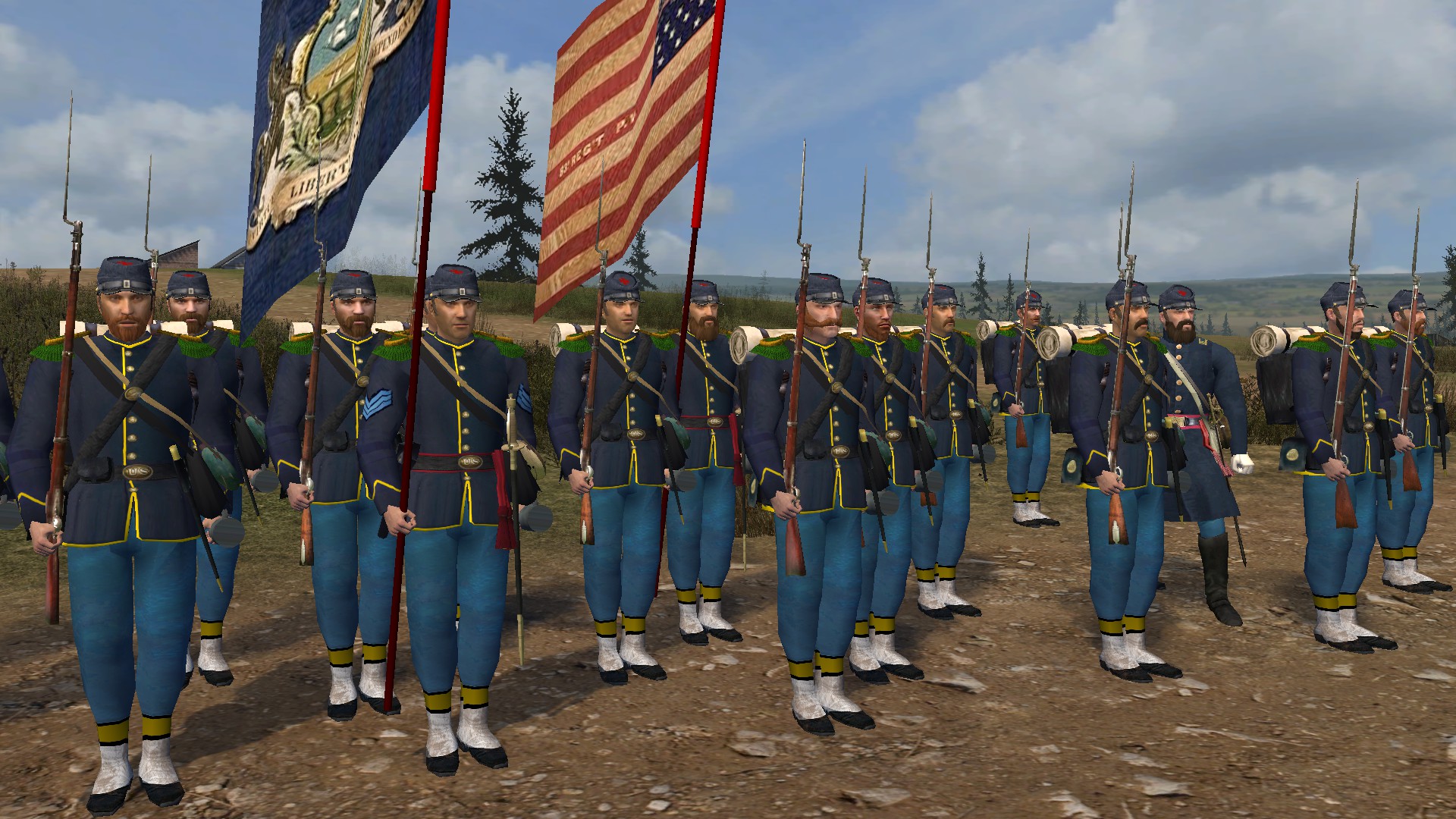
Weapons: Springfield Model 1861 Rifle Musket, Springfield Model 1855 Rifle Musket, Lorenz Rifle Model 1854, Springfield Model 1863 Rifle Musket
Faction: Army of the Potomac
Current Commander: Major General Erasmus D. Keyes
Recruitment Locations: Philadelphia, Harrisburg, Reading, Pittsburgh, Gettysburg, Williamsport, Baden, Du Bois, New Castle, Allentown, Montoursville, Dover, Lancaster, Elkton, Chambersburg
The 83rd Pennsylvania Volunteer Infantry (PVI) was mustered into Federal service in Erie, Pennsylvania, on September 8th, 1861, under the command of Colonel John McLane. Like many of the regiments recruited at the beginning of the Civil War, the 83rd’s history began with a pre-war militia unit, the "Wayne Guards", named after the famous Revolutionary war hero, General Anthony Wayne. When President Lincoln issued his first call for volunteers, the energetic McLane responded by organizing a three-month regiment, with the Wayne Guards forming the first three companies of the new regiment, and five other companies being recruited from Erie County, and two from Crawford County. The regiment was not present for the Union disaster at the Battle of First Bull Run, however the news of this disaster aroused the nation to a new sense of danger, and on July 24th, McLane received an order from Secretary of War Simon Cameron to raise a new regiment for three years of service.
By September, more than 1,000 men had responded to McLane’s call, in addition to the 300 men of the old regiment, and the unit was officially designated the 83rd in the order of its acceptance into Pennsylvania service. The regiment soon became noted for the excellence of its drill and its soldierly appearance, and were publicly acknowledged as the best shots at target firing. On one occasion, General McClellan, in passing along the lines with his staff, rode up to Colonel McLane, and said,
"Colonel, I congratulate you on having one of the very best regiments in the army".
That fall, the army held a competitive trial for drill proficiency, and the 83rd was one of two regiments awarded prized imported French uniforms. Described as being a "...uniform of the Chasseur de Vincennes, consisting of a shako, two uniforms," a cloak, a leather knapsack, and complete sets of personal and mess gear. Though the uniforms were impractical for field use and sent away before their first battle, many of the men had their photographs taken in their fancy new clothes.
The 83rd participated in almost every major battle in the East, including the Seven Days Battles, Antietam, Fredericksburg, Chancellorsville, Gettysburg, Petersburg and Appomattox Court House, earning it's well deserved reputation as "one of the very best regiments in the army." The number of battles in which this regiment was engaged, as published in orders, and recorded in the official army register of 1865, is 25, larger by two than any other Pennsylvania infantry regiment. One of it's most famous actions was at the Battle of Gettysburg, where it fought alongside the 20th Maine, 44th New York, and the 16th Michigan in the defense of Little Round Top. Colonel Strong Vincent, the regiment's commanding officer, was mortally wounded during this engagement. Due to their ability to endure harsh conditions, particularly muddy and challenging terrains, the regiment earned the nickname, "Pennsylvania Mud Turtles".
The 83rd Pennsylvania suffered the second-highest number of battle deaths among Union Army infantry regiments during the war, second only to the 5th New Hampshire. During its service, the 83rd Pennsylvania lost 11 officers and 271 men killed in combat, and 2 officers and 151 men died from disease or accidents. In total, 435 of the regiment's men died during the Civil War, amounting to 24% of its enlistments. Historian Lt. Col. William Fox described the 83rd as one of the Three Hundred Fighting Regiments:
"Blunders caused none of its losses, none occurred in disastrous routs, its dead always lay with their faces to the enemy."
Wisconsin
Iron Brigade Volunteer Infantry
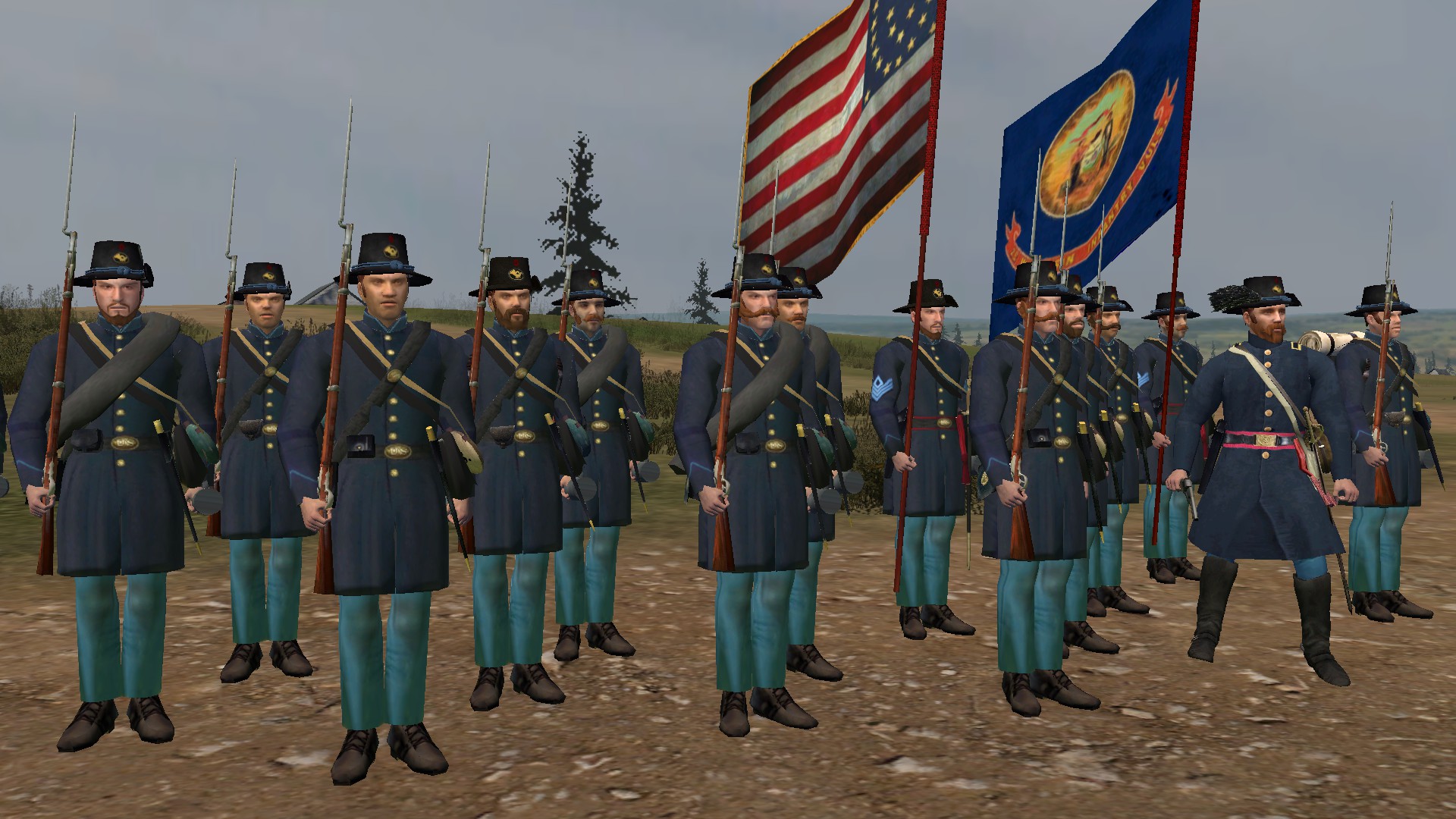
Weapons: Lorenz Rifle Model 1854
Faction: Army of the Potomac
Current Commander: Brigadier General John Gibbon
Recruitment Locations: Washington, Chicago, Madison WI, Baltimore, Detroit, Sharpsburg, Gettysburg, Fort Snelling, Monocacy, Grand Rapids, Camp Randall, Harpers Ferry, Frederick, Alexandria, De Pere, St. Paul, Lansing, Kalamazoo
The Iron Brigade, also known as The Black Hats, Black Hat Brigade, Iron Brigade of the West, and originally King's Wisconsin Brigade, was an infantry brigade in the Union Army of the Potomac, noted for its strong discipline, its unique uniform appearance and its tenacious fighting ability. The Iron Brigade suffered the highest percentage of casualties of any brigade in the war. It was a unique organization from the very first days because all the regiments were from states on the nation's frontier and it was the only all Western infantry brigade in the Eastern armies. It was not until after Gettysburg that the sectional makeup of the unit was lost with the addition of Eastern regiments to reinforce and rebuild the brigade.
As did many of the early Federal regiments, the units from Wisconsin and Indiana arrived at Washington D.C. in uniforms of state militia grey. In the coming weeks, the uniforms were slowly replaced. The uniform of the Iron Brigade differed some what to the standard uniform of the Union army at the time. It was designed to be more of a dress uniform that resembled a suit rather than the more common infantryman's kit. The Model 1858 Hardee dress hat made the best impression. It was a showy black felt affair, looped up on the side with a brass eagle and trimmed with an infantry-blue cord, black plume, brass infantry bugle, company letter and regimental numeral. The black hats made the tall Westerners look even taller, and subsequently made the brigade recognizable to friend and foe on both sides of the battle line. At Gettysburg, for example, in the very opening of the infantry fighting on July 1st, 1863, Confederates upon seeing them called out, "There are those damned Black Hats of the Army of the Potomac."
In a series of changes ordered after McClellan stalled outside Richmond, the brigade was transferred to the newly formed Army of Virginia under Major General John Pope and began a series of marches in August 1862 in attempts to locate Confederate forces under Major General Thomas J. "Stonewall" Jackson, which had left Richmond and was operating in central Virginia. It was while marching quietly along the Warrenton Turnpike near the old battlefield of Bull Run that the brigade was attacked by Jackson's troops in a battle the soldiers called Gainesville, but which is now known as Brawner's Farm. The fighting began in late afternoon of August 28th, 1862, and resulted in a stand up battle at ranges of seventy yards, as both sides stood in an open field. The four regiments fought almost alone in the gathering darkness against elements of the Stonewall Brigade of the Confederate Army. It only ended when it became too dark to continue firing. The brigade's baptism of fire was staggering. In the 6th Wisconsin, 8 were killed, 61 wounded and 3 missing, with Colonel Cutler among the wounded. The losses in the other three regiments were worse. The Seventh Wisconsin lost 164 of 580; the Nineteenth Indiana, 210 of 423; the Second Wisconsin 276 out of 430. Initial reports showed more than one-third of the brigade, 725 men, were casualties. Major Rufus Dawes of the 6th Wisconsin wrote of the battle in his memoir:
"Our one night's experience at Gainesville had eradicated our yearning for a fight. In our future history we will also be found ready but never again anxious."
In the days following the action at Gainesville, the brigade was also engaged in the battle of Second Bull Run and covered the retreat of the defeated army of John Pope. It was a few days later, September 14th, 1862, as the Federal forces followed the Confederate movement into Maryland, that the brigade fought up the National Road at South Mountain. Not long afterward, other soldiers in other regiments were not talking about a Western Brigade, or even a "Black Hat Brigade," but an "Iron Brigade of the West." It became a mighty war name that would ring down through the decades to present times. But the mighty war name came with a great cost. At the battle of Antietam on September 17th, 1862, the Western men "fought more like demons than anything else until but 400 or 500 were left of the Brigade that had 2500 as good men as ever carried guns, but two months before," a veteran of the brigade recalled. The small four regiments were reinforced by the 24th Michigan after the savage fighting in the corn field. The brigade was engaged at Fredericksburg in December 1862, and again at Chancellorsville in May of 1863.
Of course, it was at Gettysburg, on July 1st, 1863, that the Iron Brigade, now the 1st Brigade of the 1st Division of the I Army Corps, won a place in American military history and played a key role in the Union victory. Thrown into the fighting northwest of the town of Gettysburg to stall the first Confederate advance through Herbst's Woods, the brigade helped push back the Confederates in the morning and captured much of Brigadier General James J. Archer's brigade, including Archer himself. The 6th Wisconsin (along with 100 men of the brigade guard) are remembered for their famous charge on an unfinished railroad cut northwest of the town, where they captured the flag of the 2nd Mississippi and took hundreds of Confederate prisoners. However they were overwhelmed later in the day and forced to retreat through the town to the rally point on Cemetery Hill. It was the brigade's staunch defense, however, that helped to allow the Federal army to consolidate on the high ground south of Gettysburg. It was that defensive position that was the key to the Union's success. It came at terrible cost to the Western men. Of the 1,883 men engaged in Pennsylvania, 1,153 were killed, wounded or missing. 9 of the brigade's 14 field officers were killed or wounded.
With the arrival of General Ulysses S. Grant at the Army of the Potomac, the fighting took on new meaning. It went on and on, day after day, in such places as the Wilderness, Spotsylvania Court House, Cold Harbor, North Anna, and finally the new trenches around Petersburg, Virginia. The fighting continued in 1865 and it was apparent to the men in ranks of the Union army the end of the war was near. Finally, on April 1st, there was a sharp Union victory at Five Forks, Virginia, and the chase of the badly wounded Confederate Army of Northern Virginia began. It ended once and for all on April 9th, 1865. The men of the old Iron Brigade regiments were up at daylight with the others, moving along a railroad. Ahead could be heard artillery fire. The news passed back along the marching column that 20,000 rebels had surrendered, but the hard veterans shook their heads, saying it was too good to be true. Finally, the firing ahead stopped altogether and the brigade was told to make camp and that the men could erect their tents, which was something that had not been done in many days. In the distance, white flags could be seen hoisted from every tree and the word was passed that General Robert E. Lee wished for an interview with General Ulysses S. Grant. The hours passed slowly and quietly on that last day. Then, recalled a veteran of the Black Hats,
"We saw an officer come riding down the lines, his horse wet and covered with lather. As he passed along we saw the boys' caps went up in the air-the shout rang with cheers… As he came in front of us, he shouted, ‘General Lee and army had surrendered to General Grant.' Cheer-Oh, no! We yelled for joy for we know the war was ended."
Vermont
1st Vermont Brigade
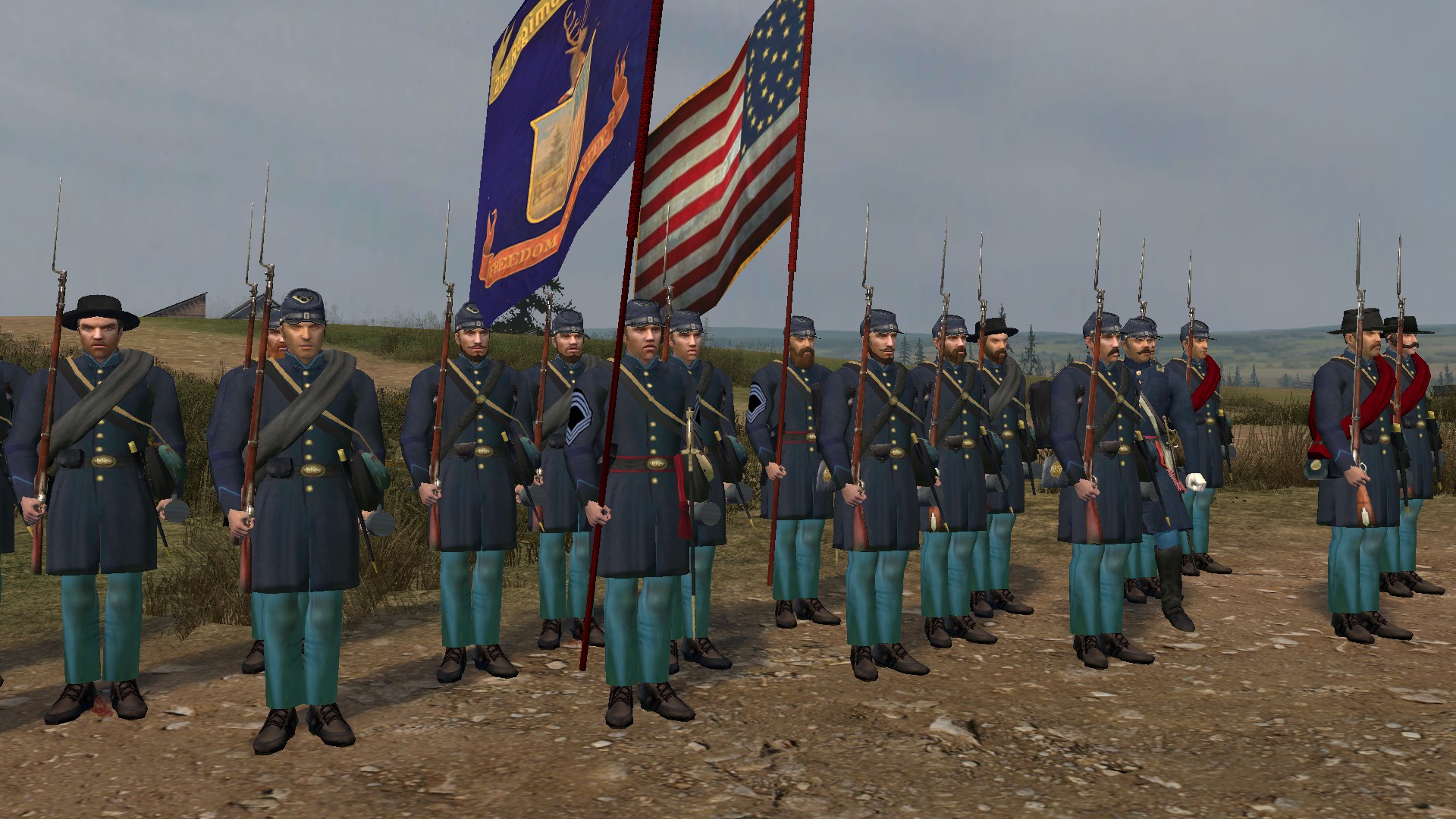
Weapons: Springfield Model 1861 Rifle Musket, Pattern 1853 Enfield Rifle Musket, Springfield Model 1855 Rifle Musket
Faction: Army of the Potomac
Current Commander: Brigadier General Lysander Cutler
Recruitment Locations: Montpelier, Portsmouth, Concord, Hartford, Portland, Burlington, Bennington
The 1st Vermont Brigade was organized in October 1861, primarily through the efforts of Major General William F. "Baldy" Smith. It was composed of the 2nd, 3rd, 4th, 5th and 6th Vermont regiments, which had been individually mustered into service between June and September. The Vermont Brigade is one of the few in the Union army whose regiments were all from the same state. Even more rare, for a short time in June and July of 1863, there were two all-Vermont brigades in the Army of the Potomac. This unit had no uniform distinctions, save perhaps an occasional red blanket which was common to New England regiments. Also, the Vermonters were keen on wearing the more formal frock coat, as well as the soft black civilian slouch hat. They had no flashy clothing, no ornaments, no specific ethnic definition. Just tough Yankees, who fought with the pure motivation of love for country, and the old flag.
In April 1862, the brigade was incorporated into the Army of the Potomac as the 2nd Brigade, 2nd Division, VI Corps, and first saw action during Major General George B. McClellan's Peninsula Campaign in the battles of Williamsburg and Savage's Station. It was later present at the battles of South Mountain, Antietam and Fredericksburg, and fought in the campaign culminating in the Battle of Chancellorsville. The Vermonters participated in the VI Corps' capture of Marye's Heights in the Second Battle of Fredericksburg and then were prominent in the fighting at Salem Church. The regiment entered into 1863 with an already established reputation as the cream of the crop of the hard fighting VI Corps, being either the first in the fight, or the last to leave one. They were held in reserve during the Battle of Gettysburg, and afterwards elements of the Vermont Brigade were sent to help quell the draft riots in New York City.
The depleted brigade received reinforcements in May 1864 when the 11th Vermont Infantry was assigned to the organization, and that same month joined in Ulysses S. Grant's Overland Campaign towards Richmond. At the Battle of the Wilderness on May 5th, Confederate Lieutenant General A.P. Hill's corps had been brought up by midday and was attacking the weak Union center along the Orange Plank Road. The Vermont Brigade took the southern flank and charged the advancing Confederates. Ordered to retreat, the 5th Vermont regiment instead launched a bayonet charge, buying time for Union troops and the rest of the Vermont Brigade to fall back to their hasty works. In less than 12 hours of fighting, losses to the brigade totaled 1,269 killed, wounded, and missing.
Early in the battle of Spotsylvania Court House, elements of the Vermont brigade, defending barricades forward of the rest of the Union Army, were ordered to retreat and spike their supporting artillery pieces before the Confederates overran them. Disobeying orders, the commander of the brigade ordered the guns to be "spiked with canister", and the brigade was able to defend the guns and works successfully until reinforcements arrived. The Vermonters suffered heavily during the ensuing assault on the Confederate defenses as the Vermont Brigade led the assault on the "Mule Shoe Salient". On June 1st, 1864, the Vermont Brigade was one of the units selected to make the ill fated charge on the Confederate earthworks at the Battle of Cold Harbor, and in less than 10 minutes, hundreds of soldiers from the Vermont Brigade were killed or wounded. In less than one month of fighting, the brigade had been reduced from 2,850 men to less than 1,200.
The Vermont Brigade fought in the Valley Campaign against Confederate Lieutenant General Jubal A. Early, under the overall command of Major General Philip Sheridan. At the Battle of Cedar Creek, Early launched a surprise attack against Sheridan's army and the 1st Vermont Brigade covered the Union army's temporary retreat, prior to Sheridan's counterattack and decisive victory. Six Medals of Honor were awarded to Vermonters at Cedar Creek, and the brigade captured three regimental colors as well as much of the 12th North Carolina regiment. Returning to Petersburg, where it was engaged until the end of the war, the 1st Vermont Brigade spearheaded the attack on the earthworks defending the city, successfully breaking through the Confederate lines on the morning of April 2nd, 1865. Six more members of the brigade were awarded the Medal of Honor for valor in this action. After the surrender of Lee's army later that month, the brigade participated in the victory parade in Washington, before returning to Vermont where the men were mustered out of service.
The 1st Vermont Brigade suffered the highest casualty count of any brigade in the history of the United States Army, with some 1,172 killed in action.
U.S. Colored Troops Infantry
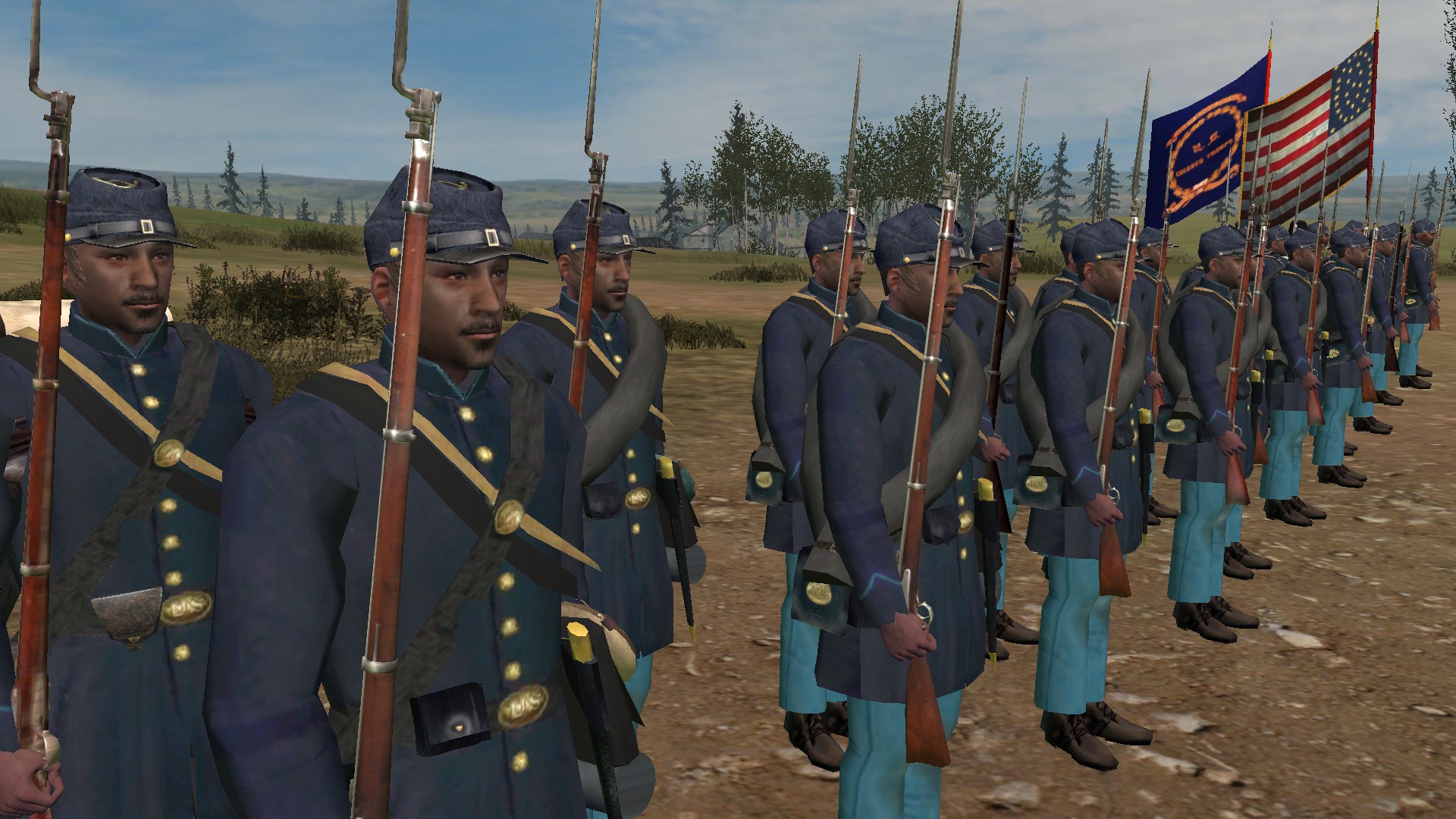
Weapons: Springfield Model 1861 Rifle Musket, Springfield Model 1863 Rifle Musket, Pattern 1853 Enfield Rifle Musket
Faction: Army of the Potomac, Army of the Cumberland, Army of the Mississippi
Current Commanders: Brigadier General Alpheus S. Williams, Brigadier General Edward Ferrero, Brigadier General Stephen G. Burbridge
Recruitment Locations: Frankfort, St. Louis, Indianapolis, Boston, Columbus, Cleveland, Baltimore, Detroit, Cincinnati, Salineville, Camp Nelson, Sharpsburg, Lexington, Fort Snelling, Grand Rapids, Fort Duffield, Burkesville, New London, Des Moines, Wheeling, Parkersburg, Jackson OH, Providence, New Wilmington, Frederick, Trenton, Jefferson City, Hodgenville, Camp Dick Robinson, St. Paul, Bennington, Lansing, Kalamazoo, Princeton, Millville, Stamford, Bridgeport, Findlay
The United States Colored Troops (USCT) were regiments in the United States Army composed primarily of African American soldiers, although members of other minority groups also served with the units. By the end of that war in April 1865, the 175 USCT regiments constituted about one-tenth of the manpower of the Union Army. About 20% of USCT soldiers died, a rate about 35% higher than that of white Union troops. Despite heavy casualties, many fought with distinction, 15 USCT soldiers receiving the Medal of Honor and numerous others receiving other honors. The courage displayed by colored troops during the Civil War played an important role in African Americans gaining new rights. As Frederick Douglass wrote:
"Once let the black man get upon his person the brass letter, U.S., let him get an eagle on his button, and a musket on his shoulder and bullets in his pocket, there is no power on earth that can deny that he has earned the right to citizenship."
In July of 1862, the U.S. Congress passed the Confiscation Act of 1862, which freed slaves whose owners were in rebellion against the United States, and the Militia Act of 1862 empowered the President to use former slaves in any capacity in the army. President Abraham Lincoln opposed early efforts to recruit African American soldiers, although he accepted the Army using them as paid workers. In September 1862, Lincoln issued his preliminary Emancipation Proclamation, announcing that all slaves in rebellious states would be free as of January 1st. Recruitment of colored regiments began in full force following the Proclamation in January 1863. The United States War Department issued General Order Number 143 on May 22nd, 1863, establishing the Bureau of Colored Troops to facilitate the recruitment of African American soldiers to fight for the Union Army. These units became known as the United States Colored Troops, although other people of color who were not of African descent, such as Native Americans, Pacific Islanders, and Asian Americans also fought under USCT regiments and made significant contributions. Regiments, including infantry, cavalry, engineers, light artillery, and heavy artillery units were recruited from all states of the Union. Approximately 175 regiments comprising more than 178,000 free blacks and former slaves served during the last two years of the war, and their service bolstered the Union war effort at a critical time.
USCT regiments were led by white officers, while rank advancement was limited for black soldiers. For a time, black soldiers received less pay than their white counterparts, but they and their supporters lobbied and eventually gained equal pay. USCT soldiers suffered extra violence at the hands of Confederate soldiers, who singled them out for mistreatment. They were often the victims of battlefield massacres and atrocities at the hands of the Confederates, most notably at Fort Pillow in Tennessee, at the Battle of the Crater in Virginia, and at the Battle of Olustee in Florida. They were often murdered when captured by Confederate soldiers, as the Confederacy announced that former slaves fighting for the Union would not be taken as prisoners of war, but instead be immediately executed. The prisoner exchange protocol inevitably broke down over the Confederacy's position on black prisoners of war.
The first engagement by African American soldiers against Confederate forces during the Civil War was at the Battle of Island Mound in Bates County, Missouri on October 28th to the 29th, 1862. African Americans, mostly escaped slaves, had been recruited into the 1st Kansas Colored Volunteers. They accompanied white troops to Missouri to break up Confederate guerrilla activities based at Hog Island near Butler, Missouri. Although outnumbered, the African American soldiers fought valiantly, and the Union forces won the engagement. USCT regiments fought in all theaters of the war, but mainly served as garrison troops in rear areas. One of the most famous USCT actions took place at the Battle of the Crater during the Siege of Petersburg, where regiments of the USCT suffered heavy casualties attempting to break through Confederate lines. Other notable engagements include the assault on Fort Wagner by the 54th Massachusetts Volunteer Infantry, one of the first major tests for the USCT, and the Battle of Nashville. USCT soldiers were among the first Union forces to enter Richmond, Virginia, after its fall in April 1865, and the 41st USCT regiment was among those present at the surrender of the Army of Northern Virginia at Appomattox. General Ulysses S. Grant praised the competent performance and bearing of the USCT, saying at Vicksburg that:
"Negro troops are easier to preserve discipline among than our white troops ... All that have been tried have fought bravely."
Sixteen African American USCT soldiers earned the Medal of Honor, the nation's highest award, for their service in the Civil War. Sergeant William Harvey Carney of the 54th Massachusetts Volunteer Infantry was awarded the Medal of Honor for his actions at the Battle of Fort Wagner in July 1863. During the advance, Carney was wounded but still went on. When the color bearer was shot, Carney grabbed the flagstaff and planted it in the parapet, while the rest of his regiment stormed the fortification. When his regiment was forced to retreat, he was wounded two more times while he carried the colors back to Union lines. He did not relinquish it until he handed it to another soldier of the 54th, saying,
"Boys, I only did my duty; the old flag never touched the ground!".
Carney received his medal 37 years after the battle. Fourteen African American soldiers, including Sergeant Major Christian Fleetwood and Sergeant Alfred B. Hilton, who was mortally wounded, of the 4th USCT, were awarded the Medal of Honor for their actions at the Battle of Chaffin's Farm in September 1864, during the campaign to take Petersburg. Corporal Andrew Jackson Smith of the 55th Massachusetts Volunteer Infantry was recommended for the Medal of Honor for his actions at the Battle of Honey Hill in November 1864. Smith prevented the regimental colors from falling into enemy hands after the color sergeant was killed. Due to a lack of official records, he was not awarded the medal until 2001.
The history of the USCT's wartime contribution was kept alive within the American black community by historians such as W. E. B. Du Bois. Since the 1970's and the expansion of historical coverage of minorities, the USCT and their contributions have been the subject of more books and movies. During the war years, the men had difficulty gaining deserved official recognition for achievement and valor. Often recommendations for decorations were filed away and ignored. Another problem was that the government would mail the award certificate and medal to the recipient, who had to pay the postage due, regardless of if he were white or black. Most former USCT recipients had to return the medals for lack of funds to redeem them.
Richard Walter Thomas, an African American scholar of race relations, observed that the relationship between white and black soldiers in the Civil War was an instance of what he calls "the other tradition":
"… after sharing the horrors of war with their black comrades in arms, many white officers experienced deep and dramatic transformations in their attitudes toward blacks."
United States Marine Corps
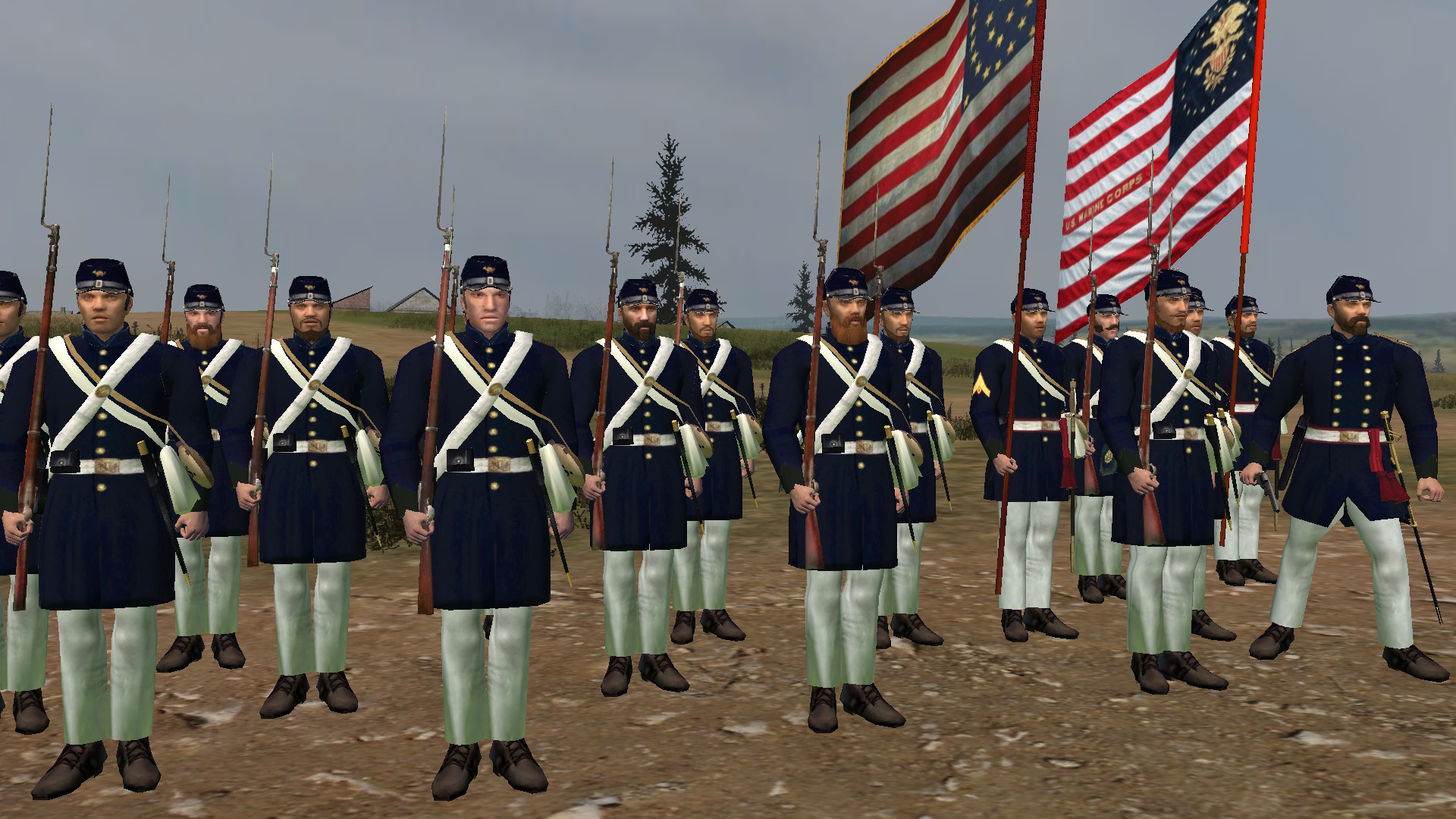
Weapons: Springfield Model 1861 Rifle Musket, Springfield Model 1855 Rifle Musket, Springfield Model 1863 Rifle Musket
Current Commander: Unassigned
Recruitment Locations: Washington, Boston, Baltimore, Monocacy, Providence, Harpers Ferry, Trenton, Alexandria, Princeton, Millville, Stamford, Bridgeport
Although today the United States Marine Corps is considered an integral part of the United States military, the Corps played a small role during the American Civil War, with their most prominent task being blockade duty. The U.S. military was ill-prepared for the magnitude of the conflict, and the the Marine Corps especially; the Corps' total strength in 1861 numbered just 63 officers and 1,712 enlisted men. As more and more states seceded from the Union, about a third of the Corps' officers left the United States to join the Confederacy and form the Confederate States Marine Corps. On July 12th, the new secretary of war, Simon Cameron, wrote to request "that the disposable effective Marines now here may be organized into a battalion and held in readiness to march on field service."
Under the command of Major John G. Reynolds, the 350 man battalion of Marines left Washington to participate in the looming battle of First Bull Run (Manassas). Reynolds' Marines were attached to Captain Charles Griffin's battery of flying artillery, known as the West Point Battery, in order to lessen the likelihood that the raw Marine recruits would see much, if any, combat in the battle. However the Marines were challenged by the artillery unit, which contained six horse-drawn cannons, racing ahead of the Marines at every opportunity, and as Reynolds reported later:
"The battery's accelerated march was such as to keep my command more or less in double-quick time; consequently the men became fatigued or exhausted in strength."
Initially, the Marines and Griffin's battery held firm, while other inexperienced Federal troops buckled under the intense fire of the Confederates and began to fall back, but the arrival by train of Confederate reinforcements led by Brigadier General Joseph E. Johnston quickly changed the course of the battle. The Union troops broke and fled, including the Marines, and without support, Griffin's battery was overrun. The Marine Corps commandant lamented that it was, "The first instance recorded in its history where any portion of [the Corps'] members turned their backs to the enemy." Nevertheless, as the least experienced soldiers in McDowell's woefully inexperienced army, the Marines gave a reasonably good account of themselves under fire, and their 13% casualty rate was nearly equal to the Regular Army battalion, the most experienced unit in the Union army at Bull Run.
Congress only slightly enlarged the size of the Marine Corps following Bull Run, due to the priority given to the Army. After filling detachments for the ships of the Navy (which had more than doubled in size by 1862), the Marine Corps was only able to field one battalion at any given time. Marines from ships' detachments, as well as ad hoc battalions, took part in the landing operations necessary to capture bases for blockade duty, and these operations were mostly successful. The Marines participated in the capture and occupation of New Orleans and Baton Rouge, Louisiana, in April and May 1862, which were key events in the war that helped secure Union control of the lower Mississippi River basin, denying the Confederacy a major port and naval base on the Gulf Coast.
Despite the Marines' participation in major land battles at First Bull Run, Fort Wagner, Tulifinny Crossroads, and Fort Fisher, the Corps' main contribution during the Civil War was aboard the ships of the blockading squadrons and inland river flotillas. At the Battle of Mobile Bay in August 1864, Marines aboard Admiral David Farragut's flagship, the sloop of war USS Hartford, helped beat back an attempt by the Confederates to ram and sink the vessel. Corporal Miles M. Oviatt, aboard the nearby sloop of war USS Brooklyn, and seven other Marines, received the Medal of Honor for their roles in the battle. Farragut himself said of the Marines, "I have always deemed the Marine guard one of the great essentials of a man-of-war.", and Rear Admiral Samuel Du Pont was even more emphatic with his praise, saying, "A ship without Marines is not a ship of war at all."
The Marine Corps' reputation as the premier amphibious unit of the United States would not reach fruition until many years later, on the islands of the South Pacific during World War II, where the Corps was able to put into effect the hard lessons learned in the Civil War: unity of command, parallel planning, rehearsed landings, and close integration of naval fire support.
Sharpshooters & Light Infantry
Berdan's Sharpshooters
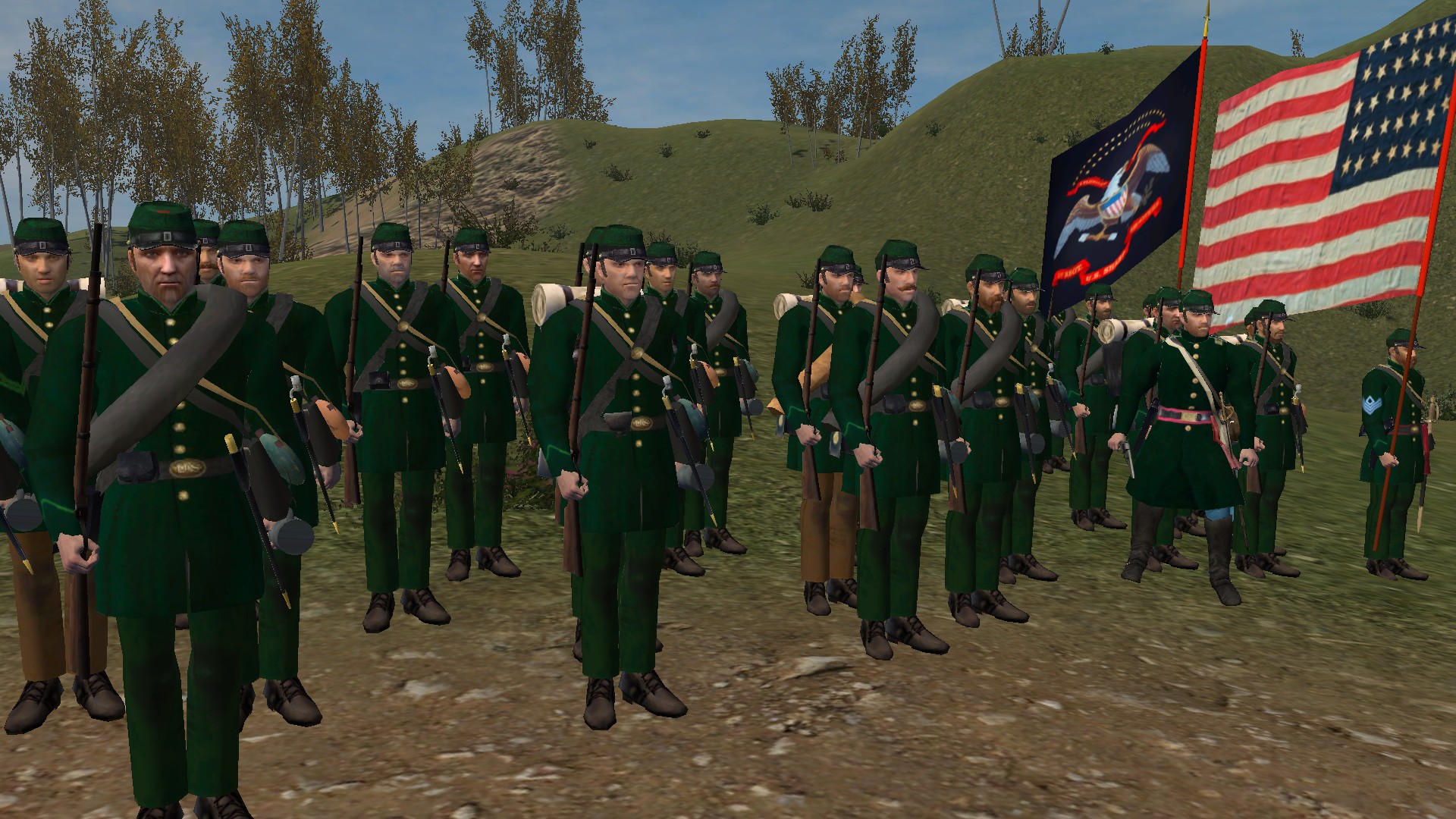
Weapons: M1859 Sharps Rifle
Faction: Army of the Potomac
Current Commander: Major General Nathaniel P. Banks
Recruitment Locations: Washington, Boston, Philadelphia, Harrisburg, Reading, Baltimore, Pittsburgh, Sharpsburg, Gettysburg, Montpelier, Monocacy, Williamsport, New London, Baden, Du Bois, Portsmouth, Providence, New Castle, Allentown, Concord, Hartford, Montoursville, Portland, Harpers Ferry, Frederick, Trenton, Dover, Alexandria, Burlington, Lancaster, Elkton, Chambersburg, Bennington, Princeton, Millville, Stamford, Bridgeport
The 1st United States Sharpshooters were an infantry regiment whose role was to kill enemy targets of importance from long range, such as officers and NCO's. The first regiment of volunteers began service in late November 1861. During their service, they fought in every Eastern battle up until the autumn of 1864. During their tour, the Sharpshooters were noted for efficient service in the battles of Yorktown, Gettysburg, Vicksburg, Chattanooga, Atlanta, Spotsylvania and Petersburg.
Hiram C. Berdan of New York State founded the Sharpshooters. The volunteer recruits had to pass a marksmanship test in order to qualify to be a member of the Sharpshooters; each man had to be able to place ten shots in a circle of 10 inches (250 mm) in diameter from 200 yards (180 m) away. They were able to choose a rifle and position of their preference for the test. A man eligible to be a Sharpshooter had to possess a keen eye, steady hands and a great deal of training and skill with a rifle. In addition to that, for a man to be a Sharpshooter, it took cool nerves in order to be able to estimate their target carefully, determine the high trajectory needed, and to take in consideration the effect that any current wind may have on the bullet as it flies through the air.
At first, many of the Sharpshooters used the Whitworth Rifle, sporting arms, and various other custom-made privately owned target weapons, but this began leading to problems when it came to ammunition supply, and as a result, Berdan made a request to receive Sharps rifles to issue to his men. Berdan chose the Sharps rifle mainly because of its fast breech loading and outstanding accuracy from long-range distances. Unfortunately, Lieutenant General Winfield Scott denied Berdan's request because he feared the issuance of Sharps rifles would lead to a waste of ammunition, but after President Abraham Lincoln watched Berdan perform a demonstration of the Sharps rifle's extreme speed and accuracy, he was so impressed that he ordered them to be immediately issued to both Sharpshooter regiments. The sharpshooters were finally issued their Sharps rifles on May 8th, 1862.
The most notable aspect of the Berdan Sharpshooter uniform is the green color, rather than the standard Union blue. They were one of only a few regiments that went outside the typical Potomac Army's uniform. The green uniform gave the sharpshooters the clear advantage of camouflage, but also sometimes was a disadvantage because they were easy to distinguish against the rest of the Union soldiers for Confederate marksmen to spot and target. Sharpshooters were high priority kills amongst the Confederate army, because they had such high skills and good salvageable equipment.
By the end of the war, ten of the regiment's officers and 143 enlisted men were killed in action or mortally wounded and 1 officer and 128 enlisted men died of disease, for a total of 282 casualties. Lieutenant Colonel William Y. W. Ripley was wounded and later received the Medal of Honor for his heroism as second in command of the 1st U.S. Sharpshooters at the Battle of Malvern Hill.
Pennsylvania Bucktails Brigade
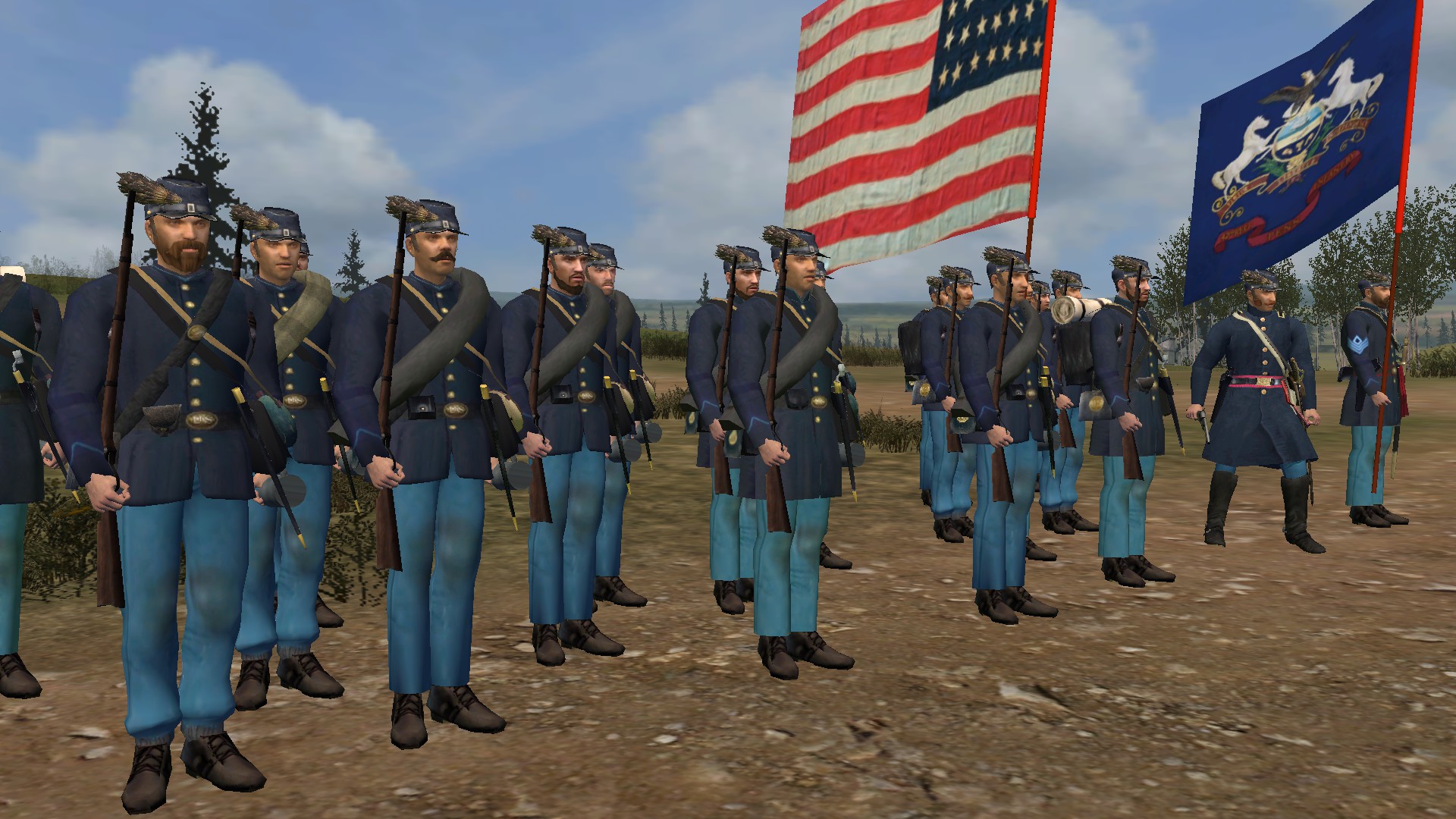
Weapons: Springfield Model 1861 Rifle Musket, Springfield Model 1855 Rifle Musket
Upgrades to: M1859 Sharps Rifle
Faction: Army of the Potomac
Current Commander: Major General Joseph Hooker
Recruitment Locations: Philadelphia, Harrisburg, Reading, Pittsburgh, Gettysburg, Williamsport, Baden, Du Bois, New Castle, Allentown, Montoursville, Dover, Lancaster, Elkton, Chambersburg
The 42nd Pennsylvania Infantry, also known as the 13th Pennsylvania Reserve Regiment, 1st Pennsylvania Rifles, Kane's Rifles, or simply as the Bucktails was a volunteer infantry regiment that was a part of the famed Pennsylvania Reserve division in the Army of the Potomac for much of the early and middle parts of the war, and served in the Eastern Theater in a number of important battles, including Antietam, Fredericksburg, and Gettysburg. The regiment was mostly made up of woodsmen and lumbermen from Western Pennsylvania who donned their hats with deer tails which caught on quickly with the rest of the men, giving the regiment their iconic nickname of "the Bucktails". Thomas Kane, the first colonel of the Bucktails, taught his men to fight as skirmishers and use whatever cover they could find. He stressed individual responsibility in his men, a contradiction to the military manuals, that favored a group mentally. The Bucktails carried breech loading Model 1859 Sharps Rifles, normally only issued to sharpshooters.
The regiment first formed in April 1861, when Thomas L. Kane sought permission to raise a company of riflemen from among the hardy woodsmen of McKean County. The regiment was initially issued .69 caliber smoothbore muskets, but some of the men would not accept them, insisting that they were a rifle regiment. They eventually received .58 caliber rifles and used these weapons through August 1862. On July 12th, a scouting party under Kane consisting of sixty men were surrounded by cavalry at New Creek Village, but fought them off, killing eight Confederates and wounding sixteen. After receiving reinforcements, Kane moved to Ridgeville which he captured after a skirmish. In the fall, the regiment was assigned to the V Corps of the Army of the Potomac, then serving in the Shenandoah Valley. On October 20th, it marched to Dranesville, where Colonel Kane was wounded in the mouth while repulsing the Confederates. During the Peninsula Campaign, the Pennsylvania Reserves division was assigned as part of the I Corps, however only part of the regiment went to the Peninsula. Companies C, G, H, and I, under the command of Kane, remained in the valley, and this provisional battalion fought in several battles of the 1862 Valley Campaign.
During the Battle of Harrisonburg on June 6th, in an attempt to rescue a Captain Haines and his wounded men of the 1st New Jersey Cavalry, the regiment held off Steuart's Brigade, including the 44th Virginia Infantry, the 58th Virginia Infantry, the 1st Maryland Infantry, and a Louisiana regiment, for an hour, killing General Turner Ashby. Colonel Kane was captured in the retreat. The 42nd had lost 52 men during this engagement, and the Confederates had lost over 500.
The other six companies of the regiment went under Major Stone, and during the retreat from Richmond, they lost one company in a swamp, then fought at Gaines Mill. Two other companies were lost during the retreat. At the retreat to Harrison's Landing, Stone and his men constructed a bridge over a stream, which quite possibly saved the Union army. Stone took command of a different regiment after this. After the Peninsula Campaign, the regiment served in the Northern Virginia Campaign and participated in the defense of Henry House Hill during the closing hours of the Second Battle of Bull Run. At Bull Run, Kane was promoted to brigadier general for covering General Pope's retreat. In early September, the two battalions were reunited under the command of Colonel Hugh W. McNeil, who had been sick, and the Pennsylvania Reserve Division, was now designated as the Third Division of the I Corps of the Army of the Potomac.
The regiment was rearmed with Model 1859 Sharps breech loading rifles prior to setting off on the Maryland Campaign. At Antietam, the regiment was decimated, losing Colonel McNeill in the fighting. The new commander was Charles Taylor, who had been captured twice by Confederates, who went on to lead the regiment in the assault on Fredericksburg. The Pennsylvania Reserves division was severely depleted from months of campaigning and in early 1863, they were sent back to Washington D.C. to rest and refit.
Prior to the Gettysburg Campaign, the 13th Pennsylvania returned to the Pennsylvania Reserves division was reassigned to the V Corps. Lieutenant Colonel Alanson E. Niles was wounded and Colonel Charles Taylor was killed at Little Round Top, leaving Major Hartshorn in command. They then marched to Spotsylvania for their final battle. The regiment was mustered out of service on June 11, 1864. Those who had reenlisted as veteran volunteers were transferred to the 190th Pennsylvania Infantry. By war's end, the Bucktails had lost a total of 239 enlisted men and 13 officers.
Birge's Western Sharpshooters

Weapons: Hawken Rifle, Henry Repeating Rifle
Faction: Army of the Mississippi
Current Commander: Major General Benjamin M. Prentiss
Recruitment Locations: Cairo, Fort Snelling, Carbondale, Vandalia, Union City, Des Moines, Springfield, Collinsville, New Madrid, Prairie du Rocher, Jefferson City, St. Paul, Marion, Mount Vernon, Effingham, Mattoon
Officially formed on November 23rd, 1861 in St. Louis, Missouri, Birge's Western Sharpshooters comprised almost ten companies, and was represented by virtually every western state. Major General John C. Fremont wanted his own group of specially trained sharpshooters as the Western Theater's counterpart to Berdan's Sharpshooters of the Army of the Potomac, and so Fremont authorized a St. Louis physician, John Ward Birge, to raise the regiment and Birge was commissioned as the regiment's colonel. Fremont required that the soldiers would "have produced satisfactory evidence of their ability to hit a target at two hundred yards, no three shots to measure more than ten inches." As marksmen, Fremont originally intended that the regiment should have a special Frontiersman look based on "hunter's dress", and be armed with highly accurate hand made Dimick Long Rifles, which were competitors to the Hawken Rifle. However Fremont ended up in a disagreement with the administration in Washington, and was replaced by Major General Henry Halleck, who discarded the idea of special uniforms and issued the regiment with the standard Union blues.
Dimick fulfilled his contract to provide the regiment with over 1,000 long rifles, although he had to scour regional and even east coast gunmakers to fulfill the enormous order for the handmade rifles in time. The Western Sharpshooters found the "Dimick Rifle" to be lethally accurate and declared themselves "well pleased" with the Plains Rifles, but as the war progressed, they found them to be unsuited to the rigors of combat, and the need for the troops to cast their own bullets further degraded its practicality. Although the regiment was already equipped with a small number of Henry Rifles, beginning in the autumn of 1863, the men of the regiment began equipping themselves with the new 16 shot Henry's, giving them a major advantage in firepower over their Confederate opponents. Over 250 of the sharpshooters spent an average of $40 out of pocket (which was over three months pay for a Private) to arm themselves with this highly effective new weapon. While the government did not purchase the weapons, it did provide ammunition for companies whose soldiers had done so.
Five companies of Birge's Sharpshooters and five companies of cavalry fought a mixed force of Missouri State Guard and secessionist volunteers at the small, but strategically important Battle of Mount Zion Church. In Grant's army the Sharpshooters saw action at the Battle of Fort Donelson and the Battle of Shiloh, and participated in General Halleck's slow advance on Corinth, Mississippi, skirmishing ahead of the main force almost every day. Three companies of the Sharpshooters marched south with Major General Rosecrans' army, participating in the Battle of Iuka on September 19th, 1862. The entire regiment fought on both days of the 2nd Battle of Corinth from October 3rd to the 4th, fighting as skirmishers on the 4th from 4:00 a.m. to around 10:00 a.m. in the timber in front of the Union fortifications, under the direct command of Colonel Patrick E. Burke, who had replaced Colonel Birge.
After being re-organized as a veteran regiment of 600 men, the Sharpshooters left for Chattanooga on May 6th, 1864, to join the Atlanta Campaign, where they were were in combat for most of 120 straight days. They opened the fighting at Snake Creek Gap and the Battle of Resaca just three days after their departure from Chattanooga, and at Resaca, the Sharpshooters singlehandedly captured the heights. Throughout the Atlanta Campaign, the regiment was used as the scouting and skirmishing spearhead of the XVI Corps and participated in ten major battles. At the First Battle of Atlanta, they were heavily engaged at Bald Hill and casualties were extremely high, especially among its officers. Both sides fought to a standstill after a small but very fierce battle, with Confederate Major General Patrick Cleburne stating that it was "the bitterest fight" of his life. Over the course of the Atlanta Campaign, the Sharpshooters suffered 225 casualties in killed and wounded.
After the Atlanta Campaign, the regiment participated in Sherman's March to the Sea and the Carolinas Campaign. Their last combat action of the war was at the Battle of Bentonville. After the surrender of the Confederate armies, the Sharpshooters marched with General Sherman in the Grand Review of the Armies on May 24th, 1865, and were discharged from service on July 7th, 1865.
1st Michigan Sharpshooters
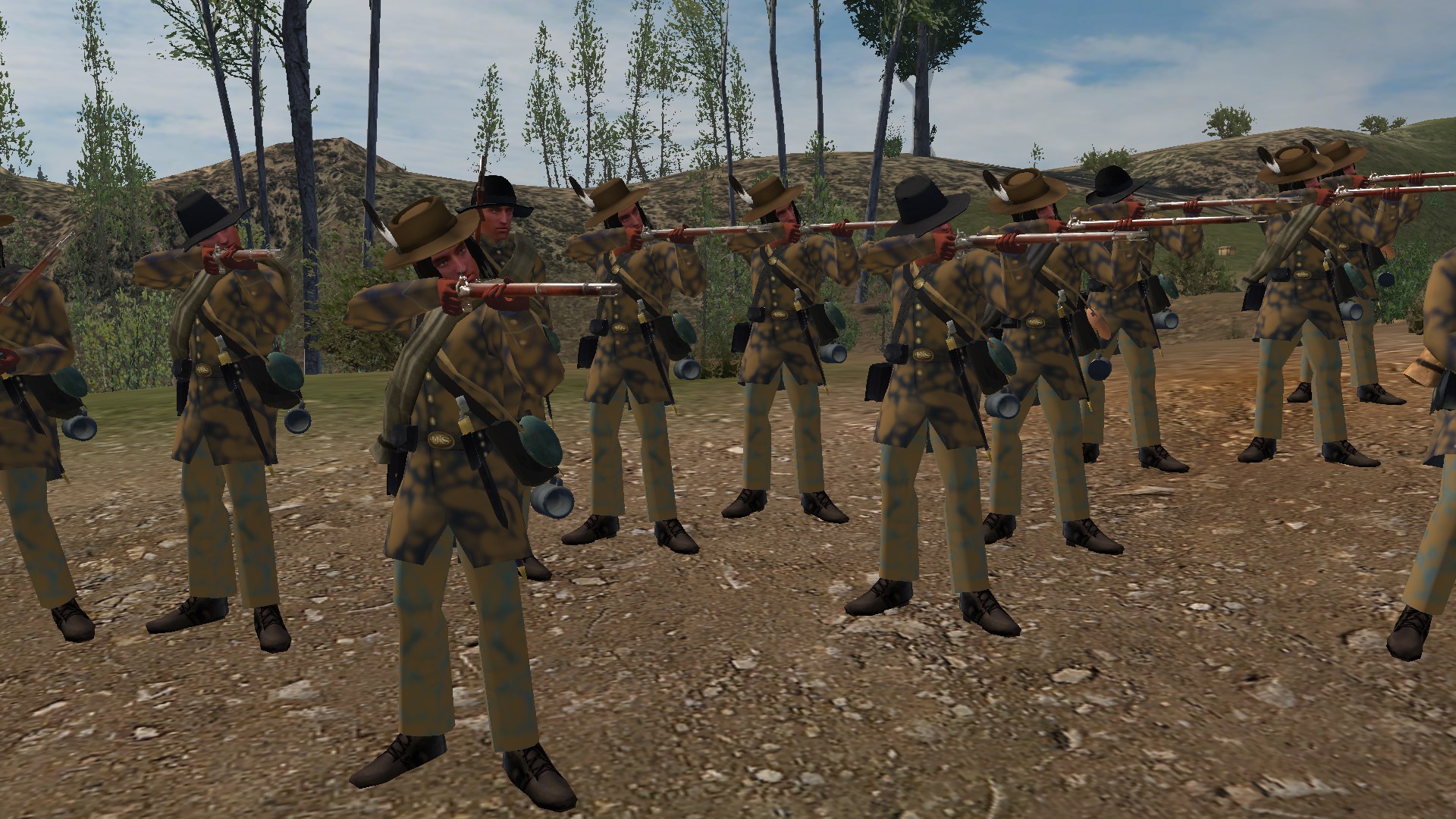
Weapons: Springfield Model 1861 Rifle Musket, Springfield Model 1863 Rifle Musket, Pattern 1853 Enfield Rifle Musket
Faction: Army of the Mississippi
Current Commander: Major General Francis J. Herron
Recruitment Locations: Frankfort, Detroit, Camp Nelson, Lexington, Grand Rapids, Burkesville, Mount Sterling, Toledo, Fremont, Bloomington, Huntington, Camp Randall, Terre Haut, Champaign, De Pere, Camp Dick Robinson, Lansing, Kalamazoo
The 1st Michigan Sharpshooters was organized at Kalamazoo and Dearborn, Michigan, between April 14th and October 7th, 1863, and of it's six companies, Company K was composed primarily of Native Americans, especially members of the Ojibwa, Odawa, and Potawatomi nations. Although some members of the regiment were armed with repeaters and breech-loaders, and despite their commander, Colonel Charles Victory DeLand's attempts to requisition 700 Henrys for the regiment, the majority of the regiment remained armed with Springfield Model 1861 rifled muskets. The men of Company K were met with vigorous training, and distinguished themselves with their marksmanship, and their ability in skirmishing and infiltration. These native troops were promised the same benefits as white soldiers, such as $13 pay a month, which outweighed the $10 monthly pay that U.S. Colored Troops (USCTs) received until equal pay was mandated.
Despite the difference in pay, those in Company K began their wartime service in the same way many USCT regiments did, by defending military storehouses, guarding Confederate prisoners, and facing not only boredom, but also disease and desertion. The native soldiers first saw action at the Battle of the Wilderness on May 6th, 1864, south of Saunders' Field.
"They, on the very first day at the front, caught on to the great advantage our enemy employed over us in the color of uniform. Ours was blue, and could be seen at a long distance; while the "Johnny" (as we called them) could not be spotted at a comparatively short distance, even when lying in an open field.
This disadvantage to us was appreciated almost immediately that these Indians got in the field, and they would go out and find a dry spot of earth and roll in it until their uniform was the complete color of the ground before going out on the skirmish line; and if the day was wet, they would not hesitate to take mud and rub it over their clothes, for as soon as this dried a little they would have what they were after—the color of the earth. This custom was adopted by my whole Regiment; and it was often remarked that our Regiment could do the closest skirmishing at the least cost of any Regiment in the Division.
Sgt. Thomas Ke-chi-ti-go, called "Big Tom" by the white Sharpshooters, further "ordered each brave to cover his breast and head with twigs and leaves to prevent contrast of color with their surroundings."
Mortally wounded in the fighting, Sergeant Charles Allen was the first casualty of war to come out of Company K. Ten more of the company's men were lost as a result of the fighting at Spotsylvania Court House on May 12th. Company K was again swept into combat when the 1st Michigan were included in a poorly executed attack on a Confederate salient around Petersburg, Virginia. While the sharpshooters obtained possession of Confederate breastworks, they were also isolated and about to be surrounded by enemy forces. Their numbers already thinned, the native soldiers battled on, engaging in hand-to-hand combat to cover the retreat of their fellow soldiers, but they were ultimately overwhelmed by the Confederates. Although Company K only suffered two casualties, the fighting on June 17th brought about a fate worse than death for more than 80 soldiers from the 1st Michigan, including 14 men from Company K, who were captured by the Confederates and sent to the notorious Andersonville prison camp. About 50% of these men never made it out alive.
The remaining members of the 1st Michigan settled into the siege around Petersburg, picketing, sniping, and digging. After the Union army detonated the mine under the Confederate trenches on July 30th, the 1st Michigan was part of the third unit to charge into the crater. There, they encountered masses of Union troops, dazed and confused, but also Confederates who, after regrouping, were fighting back. As the Confederate soldiers fired down into the crater, the Native American forces remained composed and determined amidst an impossible situation. As Union forces attempted to retreat, the 1st Michigan covered their comrades. Company K's Private Antoine Scott was among the last to remove himself from the chaos and was recommended twice for the Medal of Honor for his incredible courage under fire, but the Chippewa soldier never received recognition, and died in 1878.
Throughout its service in the Civil War, the 1st Michigan was esteemed for its solid, dependable, and effective conduct, going on to fight at the battles of Reams Station, Peebles' Farm, Hatcher's Run, and final operations around Petersburg.

